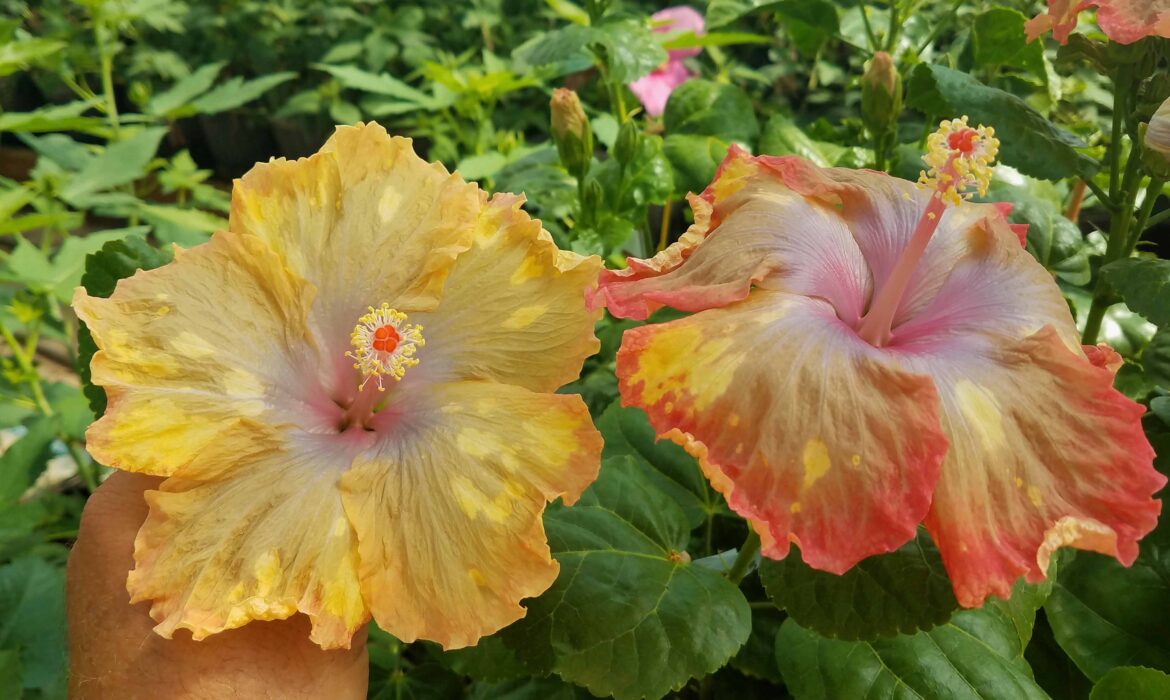Winter-hardy hibiscus cultivars are what initially attracted Dariusz Malinowski, Ph.D., Texas A&M AgriLife Research plant physiologist and breeder, to the world of flowers, but now he’s ready to splash a little tropical color into the market. Malinowski leads the forage and ornamental-plant breeding program focused on perennial cool-season forage grasses and winter-hardy hibiscus at the Texas A&M AgriLife Research and Extension Center at Vernon.
He has developed hundreds of winter-hardy hibiscus hybrids with novel flower colors in the past 10 years. The first eight cultivars were commercialized by J. Berry Nursery in 2018 and are currently some of the most sought winter-hardy hibiscus cultivars by gardeners and plant enthusiasts.
Recently, Malinowski and coauthors published in Frontiers of Science a breakthrough paper describing the first winter-hardy hibiscus hybrids created in their program — hybrids expressing floral phenotypic traits closely resembling flowers of tropical hibiscus.
The paper is available at https://www.frontiersin.org/articles/10.3389/fpls.2019.01528/full.
But Malinowski has something else in the pipeline now — new, unusual tropical hibiscuses.
Tropical-hibiscus venture
“Many of my peers suggested I start a tropical-hibiscus breeding program as a logical addition to my winter-hardy hibiscus-breeding program years ago,” Malinowski recalled. “I hesitated at first because there are already about 19,000 tropical-hibiscus hybrids registered with the International Hibiscus Society as of 2019.”
Unlike winter-hardy hibiscus, Malinowski said that tropical hibiscuses have been bred for almost 400 years and today come in a wide variety of colors and color combinations. He did not believe he could develop cultivars that would stand out among the thousands of existing ones.
But he changed his mind in 2015. Now, after four years of the project, Malinowski has disclosed to Texas A&M AgriLife Research Intellectual Property and Commercialization office about 100 unique tropical-hibiscus hybrid lines.
The first tropical hybrids from his breeding program have just been presented to commercial partners for potential evaluation and commercialization. Companies usually require two to three years for evaluation before they select cultivars for commercialization. Thus, the first AgriLife Research tropical-hibiscus cultivars may be expected on the market in 2023, Malinowski noted. “I decided to use the same breeding strategy that I previously applied in the winter-hardy hibiscus breeding, i.e., create as much genetic variation as possible.”
Multiple tropical traits AND selections
“Right from the beginning,” Malinowski added, “I cooperated with one of our commercial partners to breed not only for novel flower colors and shapes, but also for other traits that are important for plant growers, such as dwarf plant-growth habit, colorful foliage and extended blooming time.” As a result, he has been able to generate the first hybrids with purple foliage, where the dark pigment is expressed independently from UV radiation.
Malinowski also took on another challenge to improve the tropical flowers. “Typically, flowers of tropical hibiscuses last for only one day, and the biggest challenge for us has been the development of hybrids with flowers lasting for two days or even longer.” In 2019, he was able to grow and select several hybrids blooming for two or three days, even at temperatures in the mid-90s.
Another trait that puts Malinowski’s program ahead of the competition are flowers that change color from one day to another. Among the hybrids with flowers lasting a couple of days, he has selected a few lines with flowers that have completely different colors on each day of blooming.
“Some tropical cultivars have flowers with colors highly dependent on temperature and intensity of solar radiation,” he said. “However, our hybrids change flower colors in response to an indigenous mechanism and not in response to varying temperature or growing seasons.”
Breeding for hibiscus uniqueness
Malinowski said another novel aspect of his tropical-hibiscus breeding program is developing plants with a weeping or prostrate growth habit. “Such cultivars are not commercially available yet, but our hybrids look very interesting when grown in hanging baskets on a porch, just like ferns, but with colorful flowers.”
A totally new goal of Malinowski’s breeding program is to develop tropical hibiscuses with increased tolerance to cold. Typically, tropical cultivars will cease growth at temperatures below 50 degrees and die if such temperatures last for an extended period. And, he observed, freezing temperatures will kill the plants immediately.
For the past year, Malinowski has been interacting with Jose Matus and Jose Carlos Gomez-Pascual, amateur tropical-hibiscus breeders from the Canary Islands, Spain. Matus and Gomez-Pascual developed a number of hybrids based on old, naturalized tropical-hibiscus plants collected across Spain, including plants grown in areas that typically experience frost in winter. “I am very excited about these unique hybrids because they are so different from common tropical-hibiscus cultivars, both in flower and foliage shape,” Malinowski mentioned.
By Kay Ledbetter
Texas A&M AgriLife Extension Service

